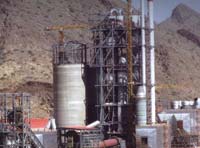The Arab cement industry: present and future
In consequence to the higher demand for cement in the Arab countries over the past few years, many of them became cement importers, having previously been main exporters before the end of the 20th century. Its expansion was closely linked to the building and construction industry, which witnessed unprecedented growth in many of them. This resulted in higher demand for cement at 10 - 15%, reaching to more than 20% in Qatar.
In consequence to the higher demand for cement in the Arab countries over the past few years, most Arab countries became cement importers, having previously been main exporters before the end of the 20th century. The construction sector's share of the Arab GDP was more than US$ 62 billion in 2006, representing 5% of Arab GDP, of which US$ 33.5 billion come from the GCC countries, US$ 16.6 billion from Maghreb countries and US$ 10.5 billion from the Mashreq countries. *
A current overview
The number of cement factories in Arab countries is 138 plants, of which 118 are integrated plants (clinker and cement), 10 cement mills and 10 packaging stations and silos. These facilities are distributed as follows: 52 in Mashreq countries, 46 in Maghreb countries and 42 in the GCC countries. Total design capacity of these plants was 152.6 million t of clinker and 181.7 million t of cement in 2007, and these capacities rose at 7% as of 2005, as a result of expansions in existing plants and starting production of the newly completed cement plants.
 Actual production registered 13.3 million t of clinker and 154 million t of cement in 2007, namely at 87% of design capacity of clinker and 85% of design capacity of cement. However, this rate varies from one country to another as many of these plants have achieved, and even exceeded, their design capacities. With the addition of new capacities, actual clinker production increased at an annual rate of 6.6% and that of cement increased at 8.8%.
Actual production registered 13.3 million t of clinker and 154 million t of cement in 2007, namely at 87% of design capacity of clinker and 85% of design capacity of cement. However, this rate varies from one country to another as many of these plants have achieved, and even exceeded, their design capacities. With the addition of new capacities, actual clinker production increased at an annual rate of 6.6% and that of cement increased at 8.8%.
Apparent consumption reached 160 million t, increasing at 11% during 2005 - 2007, which clearly reflects demand growth rate for cement during this period.
As for Arab cement trade, exports declined notably as of 2005, decreasing at 40% in 2005 and maintaining a volume of 11.5 million t due to increased local demand. Imports increased considerably, registering 61% in 2005, reaching a volume of 27 million t during 2007 with a view to meet local demand, particularly in some GCC and Mashreq countries.
A view of the future
The above shows that the Arab cement industry registered significant growth during the past few years. However, this development did not stop, as several new projects and plants, in addition to expansions, are being implemented or are under consideration. This means that this industry receives additional capacities every year. Information available at the AUCBM indicates that the number of new plants and mills under construction amounts to more than 100 new plants, with a total design capacity of more than 150 million t. Furthermore, if we add these capacities to existing ones, total capacity will exceed 300 million t in 2011.

Arab Mashreq countries occupy the first position, with planned new factories amounting to 50 units at a capacity of 70 million t, followed by GCC countries with a capacity of 68 million t, then Arab Maghreb countries with 22 plants at a capacity of 17 million t. It is worth mentioning that owners of some of these plants have obtained licenses but did not start work, for certain reasons, which confirms that they were not serious in execution.
No doubt, the new additional capacities from plants and expansions, which were implemented during the last three years, will increase total capacities in many Arab countries. This could lead to difficulties in merchandising the surplus, particularly given that completion or implementing all the new proposed projects will double current production capacities. Add to this, the new situation will increase the fierce competition in local markets and will be reflected negatively on prices and the future of this industry.
Note
* Mashreq countries: Egypt, Iraq, Lebanon, Palestine, Sudan, Syria, and Yemen. GCC countries: Bahrain, Kuwait, Oman, Qatar, Saudi Arabia, and UAE. Maghreb countries: Algeria, Libya, Mauritania, Morocco, and Tunisia.
Author: Eng. Ahmad Al-Rousan, Secretary General, Arab Union for Cement and Building Materials. www.aucbm.org
Read the article online at: https://www.worldcement.com/africa-middle-east/01102009/the_arab_cement_industry_present_and_future/
You might also like
The World Cement Podcast - CleanTech & Venture Capital
Our guest for this episode of the World Cement Podcast is Alfredo Carrato, Venture Capital Advisor for CEMEX Ventures. Listen in to the conversation as World Cement's Senior Editor, David Bizley, and Alfredo discuss the role of venture capital and cleantech in enabling the cement industry's green transition.
Tune in to the World Cement Podcast on your favourite podcast app today.

